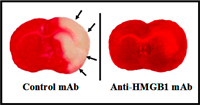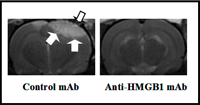Enlarge Image Fig. 2. Arrows indicate edematous area induced by traumatic brain injury.
Enlarge Image
The invention of an antibody drug for the treatment of brain infarction
Brain infarction is one of the major causes of death in industrially advanced countries. In ischemic stroke, interruption of blood flow by thrombus or embolus induces neuronal death in the ischemic core as a result of the inability to maintain membrane ion gradients in neurons, excitotoxicity due to elevated glutamate levels, and disruption of the blood-brain barrier. A diversity of neuroprotective candidate drugs targeting varieties of factors associated with ischemic insult have been subjected to preclinical and clinical studies. Despite these extensive efforts, an effective therapy has not yet been successfully established.
High mobility group box-1 (HMGB1), originally identified as an architectural nuclear protein, exhibits an inflammatory cytokine-like activity in the extracellular space. HMGB1 was reported to be released from necrotic cells. Therefore, it was hypothesized that this factor may be released from plural types of cells in the brain during ischemic insult leading to facilitation of inflammatory response and that the regulation of the activity of HMGB1 may produce a beneficial effect on brain tissue. Three rat monoclonal antibodies (mAb) against bovine HMGB1 were raised and characterized. One clone (#10-22) recognized C-terminal sequence of HMGB1 protein.
Treatment with this neutralizing mAb remarkably ameliorated brain infarction induced by 2-h occlusion of the middle cerebral artery in rats, even when the mAb was administered after the start of reperfusion (Fig. 1). Consistent with 90 % reduction in infarct size, the accompanying neurological deficits in locomotor function were significantly improved. Notably, anti-HMGB1 mAb protected the structure of blood-brain barrier and inhibited the increased permeability of the blood-brain barrier. Moreover, the mAb suppressed the brain edema induced by traumatic brain injury (Fig.2). This invention for neutralizing anti-HMGB1 mAb provides a novel therapeutic strategy for ischemic stroke and traumatic brain injury.
Further information
Invention: Brain infarction inhibitor
Patent number: PCT/JP2006/320436, WO2007/049468 A1.
Inventors: Masahiro Nishibori, Shuji Mori, Hideo Takahashi, Yasuko Tomono, Naoto Adachi, Keyue Liu
Affiliation: Okayama University, Okayama, Japan.


